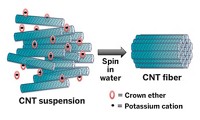Advertisement
Grab your lab coat. Let's get started
Welcome!
Welcome!
Create an account below to get 6 C&EN articles per month, receive newsletters and more - all free.
It seems this is your first time logging in online. Please enter the following information to continue.
As an ACS member you automatically get access to this site. All we need is few more details to create your reading experience.
Not you? Sign in with a different account.
Not you? Sign in with a different account.
ERROR 1
ERROR 1
ERROR 2
ERROR 2
ERROR 2
ERROR 2
ERROR 2
Password and Confirm password must match.
If you have an ACS member number, please enter it here so we can link this account to your membership. (optional)
ERROR 2
ACS values your privacy. By submitting your information, you are gaining access to C&EN and subscribing to our weekly newsletter. We use the information you provide to make your reading experience better, and we will never sell your data to third party members.
Energy Storage
Deep-Frying Graphene Spheres For Energy Storage
Materials: Spraying graphene oxide into hot solvent creates high-surface-area graphene particles suitable for building electrodes
by Prachi Patel
January 14, 2015

Materials scientists have constructed round, pom-pom-like graphene microparticles by spraying graphene oxide droplets into a hot solvent—a process akin to deep-frying (Chem. Mater. 2014, DOI: 10.1021/cm5034244). The technique could provide a simple, versatile means to make electrode materials for batteries and supercapacitors, possibly leading to devices with improved energy and power densities, the researchers say.
Scientists want to use graphene in electrodes because it has excellent conductivity, stability, and high surface area. However, standard graphene production methods yield thin films that aggregate or stack, reducing surface area and making the material difficult to process.
To harness the material’s electrical and mechanical properties while retaining its high surface area, researchers have recently tried to create three-dimensional graphene structures. Several groups have made graphene foams and aerogels. But these are unsuitable for electrodes because they are too bulky and irregular, and they have a low density of the carbon material, says Sang-Hoon Park, a materials scientist at Yonsei University, in Seoul, South Korea. A few other groups have made less bulky graphene nanospheres and microspheres using 3-D templates and techniques such as chemical vapor deposition and freeze-drying.
Park and colleagues, including Kwang-Bum Kim of Yonsei University and Kwang Chul Roh of the Korea Institute of Ceramic Engineering & Technology, decided to take this second route. However, while others have made spheres that look like hollow balls or wads of crumpled paper, the Korean team’s particles resemble pom-poms: They contain graphene nanosheets radiating out from the center. The arrangement increases the exposed surface area of the graphene and creates open nanochannels that can enhance charge transfer, Park says.
The researchers simply passed an aqueous suspension of graphene oxide flakes through an ultrasonic nozzle, which uses sound waves to break the suspension into microdroplets. They sprayed the droplets downward into a 160 °C mixture of an organic solvent and ascorbic acid, a reducing agent.

In the hot mixture, graphene oxide reduces to graphene sheets that then clump together. The water in the droplets evaporates and escapes toward the droplet surface. “This rapid evaporation of water, we believe, is responsible for the radially outward arrangement of the graphene nanosheets,” Park says. The 5-μm-diameter graphene microspheres precipitated out of the solution, and the researchers filtered them out.
The team also made silicon-loaded graphene particles by starting with a suspension of silicon nanoparticles and graphene oxide. Silicon is a promising material for lithium-ion battery anodes because of its high charge-storage capacity, but anodes made from it swell and distort during charge and discharge. Encapsulating it in a carbon scaffold overcomes this problem.
To test the graphene-only spheres, the researchers fabricated 1- by 1-cm electrodes with a slurry of the materials. They immersed the electrode and another made from unassembled graphene sheets in a sulfuric acid electrolyte. The microsphere electrode had a capacitance of 151 farad per gram compared with 118 F/g for the plain graphene electrode, demonstrating that the 3-D structure of the particles improved performance.
The capacitance of the pom-pom graphene electrodes, while impressive, is comparable to other electrodes made with 3-D graphene materials, says Shu-Hong Yu, a chemist and nanoscientist at the University of Science & Technology of China. But the deep-frying technique makes this work novel and important. Compared with other methods for making 3-D graphene, it is “direct, simple, and much easier to scale up for industrial applications,” he says. Another key advantage is that the method allows functional nanoparticles to be trapped directly into the microspheres to form nanocomposites.




Join the conversation
Contact the reporter
Submit a Letter to the Editor for publication
Engage with us on Twitter